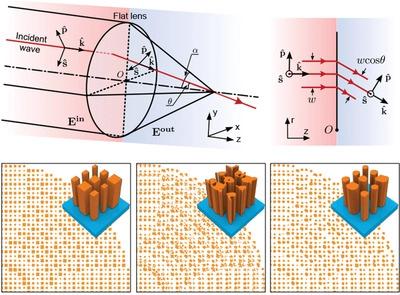当前位置:
X-MOL 学术
›
Laser Photonics Rev.
›
论文详情
Our official English website, www.x-mol.net, welcomes your feedback! (Note: you will need to create a separate account there.)
Toward High-Efficiency Ultrahigh Numerical Aperture Freeform Metalens: From Vector Diffraction Theory to Topology Optimization
Laser & Photonics Reviews ( IF 11.0 ) Pub Date : 2022-08-11 , DOI: 10.1002/lpor.202200265 Di Sang 1, 2, 3 , Mingfeng Xu 1, 2 , Mingbo Pu 1, 2, 4 , Fei Zhang 1, 2 , Yinghui Guo 1, 2, 4 , Xiong Li 1, 4 , Xiaoliang Ma 1, 4 , Yunqi Fu 3 , Xiangang Luo 1, 4
Laser & Photonics Reviews ( IF 11.0 ) Pub Date : 2022-08-11 , DOI: 10.1002/lpor.202200265 Di Sang 1, 2, 3 , Mingfeng Xu 1, 2 , Mingbo Pu 1, 2, 4 , Fei Zhang 1, 2 , Yinghui Guo 1, 2, 4 , Xiong Li 1, 4 , Xiaoliang Ma 1, 4 , Yunqi Fu 3 , Xiangang Luo 1, 4
Affiliation

|
Optical metasurface is a 2D array of subwavelength meta-atoms that arbitrarily manipulates amplitude, polarization, and wavefront of incident light, offering great advantages in miniaturization and integration. However, the presuppositions hidden in conventional unit-cell-based design approach, including discrete phase sampling, local periodicity approximation, and normal response, imply that the responses and interactions of meta-atoms are almost impossible to be accurately modeled, thus impeding the effective design of high-efficiency ultrahigh numerical aperture (NA) metalens. Here, based on vector diffraction theory and plane wave expansion method, theoretical limitation of metalens efficiency is comprehensively investigated. It is identified that for high-NA metalens, theoretical focusing efficiency is limited by diffraction capability of vector field, while evanescent wave attenuation dominates theoretical efficiency decline for ultrahigh-NA metalens. It is also shown that the efficiency of conventional metalens has a huge gap from theoretical limitation, owing to imperfect diffractive focusing and impedance mismatch reflections. To fill such efficiency gap, the high-efficiency high-NA freeform metalens based on topology optimization is further demonstrated. Particularly, topology geometric constraints are utilized to reduce minimum feature size while keeping high efficiency. The results could shed new light on the understanding and design of ultrahigh-NA metalens and find promising applications in optical imaging, microscopy, and lithography.
中文翻译:

迈向高效超高数值孔径自由曲面元透镜:从矢量衍射理论到拓扑优化
光学超表面是亚波长元原子的二维阵列,可任意操纵入射光的幅度、偏振和波前,在小型化和集成方面具有很大优势。然而,隐藏在传统的基于单位单元的设计方法中的假设,包括离散相位采样、局部周期性近似和正常响应,意味着元原子的响应和相互作用几乎不可能被准确地建模,从而阻碍了有效的高效超高数值孔径(NA)元透镜的设计。在此,基于矢量衍射理论和平面波展开法,全面研究了元透镜效率的理论限制。确定对于高 NA 元透镜,理论聚焦效率受到矢量场衍射能力的限制,而倏逝波衰减主导了超高NA超透镜的理论效率下降。还表明,由于不完美的衍射聚焦和阻抗失配反射,传统超透镜的效率与理论限制存在巨大差距。为了填补这种效率差距,进一步展示了基于拓扑优化的高效高NA自由形式元透镜。特别是,拓扑几何约束被用来减少最小特征尺寸,同时保持高效率。该结果可以为理解和设计超高 NA 元透镜提供新的思路,并在光学成像、显微镜和光刻中找到有前景的应用。而倏逝波衰减主导了超高 NA 元透镜的理论效率下降。还表明,由于不完美的衍射聚焦和阻抗失配反射,传统超透镜的效率与理论限制存在巨大差距。为了填补这种效率差距,进一步展示了基于拓扑优化的高效高NA自由形式元透镜。特别是,拓扑几何约束被用来减少最小特征尺寸,同时保持高效率。该结果可以为理解和设计超高 NA 元透镜提供新的思路,并在光学成像、显微镜和光刻中找到有前景的应用。而倏逝波衰减主导了超高 NA 元透镜的理论效率下降。还表明,由于不完美的衍射聚焦和阻抗失配反射,传统超透镜的效率与理论限制存在巨大差距。为了填补这种效率差距,进一步展示了基于拓扑优化的高效高NA自由形式元透镜。特别是,拓扑几何约束被用来减少最小特征尺寸,同时保持高效率。该结果可以为理解和设计超高 NA 元透镜提供新的思路,并在光学成像、显微镜和光刻中找到有前景的应用。由于不完美的衍射聚焦和阻抗失配反射。为了填补这种效率差距,进一步展示了基于拓扑优化的高效高NA自由形式元透镜。特别是,拓扑几何约束被用来减少最小特征尺寸,同时保持高效率。该结果可以为理解和设计超高 NA 元透镜提供新的思路,并在光学成像、显微镜和光刻中找到有前景的应用。由于不完美的衍射聚焦和阻抗失配反射。为了填补这种效率差距,进一步展示了基于拓扑优化的高效高NA自由形式元透镜。特别是,拓扑几何约束被用来减少最小特征尺寸,同时保持高效率。该结果可以为理解和设计超高 NA 元透镜提供新的思路,并在光学成像、显微镜和光刻中找到有前景的应用。
更新日期:2022-08-11
中文翻译:

迈向高效超高数值孔径自由曲面元透镜:从矢量衍射理论到拓扑优化
光学超表面是亚波长元原子的二维阵列,可任意操纵入射光的幅度、偏振和波前,在小型化和集成方面具有很大优势。然而,隐藏在传统的基于单位单元的设计方法中的假设,包括离散相位采样、局部周期性近似和正常响应,意味着元原子的响应和相互作用几乎不可能被准确地建模,从而阻碍了有效的高效超高数值孔径(NA)元透镜的设计。在此,基于矢量衍射理论和平面波展开法,全面研究了元透镜效率的理论限制。确定对于高 NA 元透镜,理论聚焦效率受到矢量场衍射能力的限制,而倏逝波衰减主导了超高NA超透镜的理论效率下降。还表明,由于不完美的衍射聚焦和阻抗失配反射,传统超透镜的效率与理论限制存在巨大差距。为了填补这种效率差距,进一步展示了基于拓扑优化的高效高NA自由形式元透镜。特别是,拓扑几何约束被用来减少最小特征尺寸,同时保持高效率。该结果可以为理解和设计超高 NA 元透镜提供新的思路,并在光学成像、显微镜和光刻中找到有前景的应用。而倏逝波衰减主导了超高 NA 元透镜的理论效率下降。还表明,由于不完美的衍射聚焦和阻抗失配反射,传统超透镜的效率与理论限制存在巨大差距。为了填补这种效率差距,进一步展示了基于拓扑优化的高效高NA自由形式元透镜。特别是,拓扑几何约束被用来减少最小特征尺寸,同时保持高效率。该结果可以为理解和设计超高 NA 元透镜提供新的思路,并在光学成像、显微镜和光刻中找到有前景的应用。而倏逝波衰减主导了超高 NA 元透镜的理论效率下降。还表明,由于不完美的衍射聚焦和阻抗失配反射,传统超透镜的效率与理论限制存在巨大差距。为了填补这种效率差距,进一步展示了基于拓扑优化的高效高NA自由形式元透镜。特别是,拓扑几何约束被用来减少最小特征尺寸,同时保持高效率。该结果可以为理解和设计超高 NA 元透镜提供新的思路,并在光学成像、显微镜和光刻中找到有前景的应用。由于不完美的衍射聚焦和阻抗失配反射。为了填补这种效率差距,进一步展示了基于拓扑优化的高效高NA自由形式元透镜。特别是,拓扑几何约束被用来减少最小特征尺寸,同时保持高效率。该结果可以为理解和设计超高 NA 元透镜提供新的思路,并在光学成像、显微镜和光刻中找到有前景的应用。由于不完美的衍射聚焦和阻抗失配反射。为了填补这种效率差距,进一步展示了基于拓扑优化的高效高NA自由形式元透镜。特别是,拓扑几何约束被用来减少最小特征尺寸,同时保持高效率。该结果可以为理解和设计超高 NA 元透镜提供新的思路,并在光学成像、显微镜和光刻中找到有前景的应用。


























 京公网安备 11010802027423号
京公网安备 11010802027423号